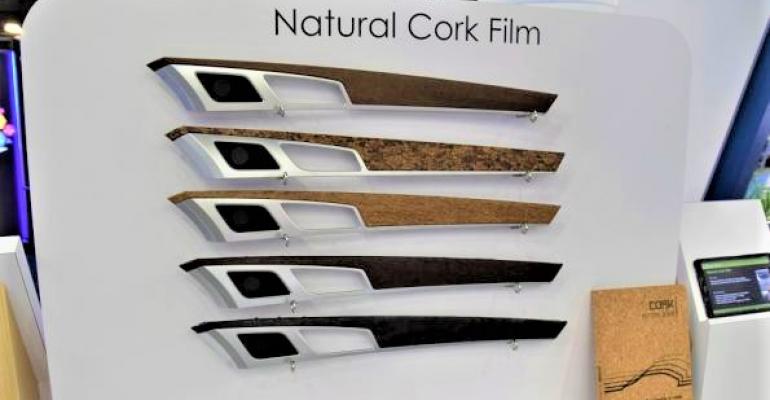DETROIT – Real wood is one of the hottest interior trim materials for luxury vehicles. It brings beauty, warmth and authenticity to any cabin and drivers and passengers love the way it looks and feels. The downside is the real thing is heavy, raises durability issues and is very costly. Even modest amounts of real wood trim can cost an automaker $1,000 or more per vehicle.
Korean supplier Seoyon says it has the answer: cork. It is soft and natural to the touch, available in a variety of attractive patterns and half the cost of real wood trim. Some of the patterns look like cork, others look like wood. A thin layer of non-woven fabric provides the pattern and a clear-coat top layer provides durability.
The material already has been mass produced as an interior door garnish in the Hyundai Grandeur Hybrid sold in South Korea, and it was a finalist for a 2017 Society of Plastics Engineers Innovation award in the U.S.
Seoyon, which has a U.S. headquarters in Auburn Hills, MI, has numerous cork trim parts and patterns on display at the SAE World Congress Experience here that are attractive and have a very natural feel.
A spokesman explains that natural wood trim pieces aren’t just pieces of wood, but are complex structures comprised of multiple layers of wood veneer, aluminum and three layers of adhesive which are formed by a complex molding and machining process with about 20 steps. Real wood also is difficult to bend into various shapes.
Cork trim parts are less expensive because manufacturing is simpler, requiring only five steps instead of 20. They are made by stacking several real cork veneers on a plastic surface and forming it into trim parts through a simple insert-molding process. Cork also is more elastic and easier to form than wood, which increases design freedom and limits scrap rates.

In a presentation to SPE last fall, a Hyundai spokesman said natural cork has good heat and UV resistance and is eco-friendly because harvesting cork bark does not require cutting down trees. The manufacturing process also is friendly to the environment. He added that the Grandeur application resulted in a 65% cost reduction and 24% weight reduction compared with real wood trim.
Both Hyundai and Seoyon say the goal with cork is not to replace real wood in luxury cars, but to offer economical, natural-material trim for mid-priced vehicles.






